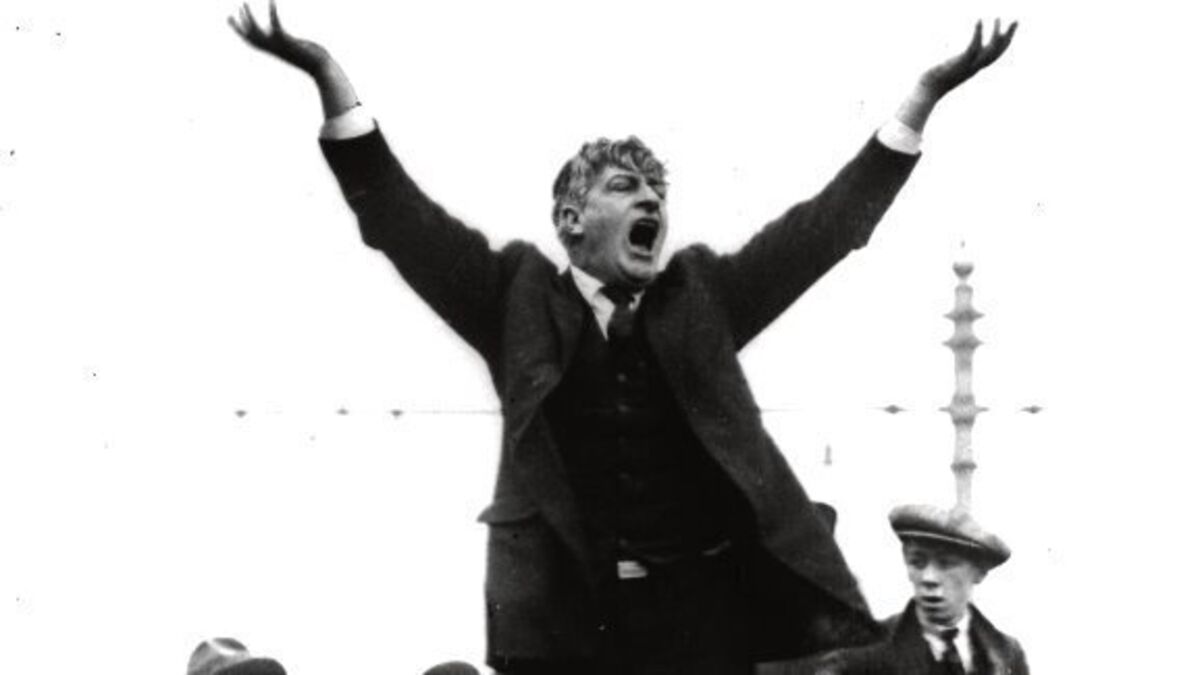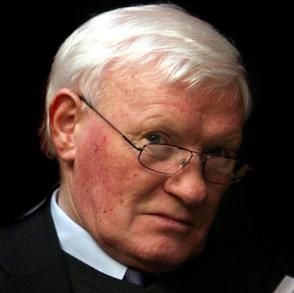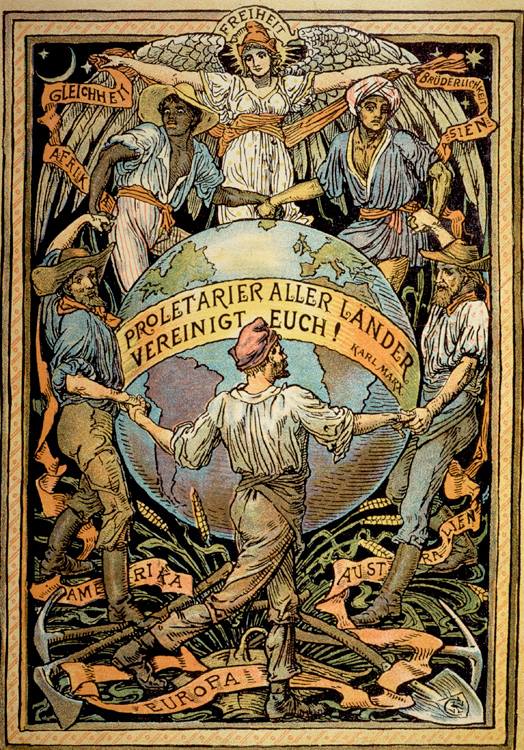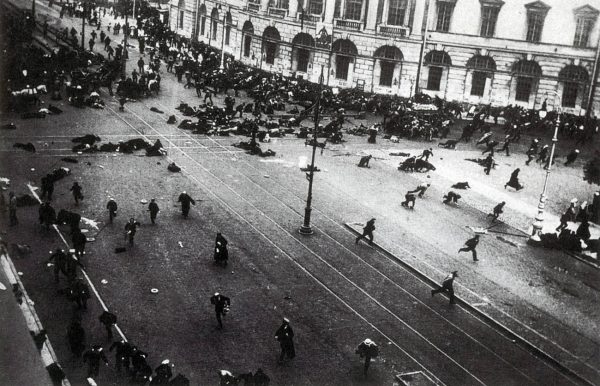A Commemoration of Jim Larkin 75 years on from his death
Claire O’Connor examines the legacy of Jim Larkin 75 years after his death.
Sunday. August 31st. 1913. A crowd of thousands of Dublin men and women shift around restlessly on O’Connell Street. The air hangs heavy with anticipation. Somewhere – lying in wait in the grey city din – is their hope, their promise of inspiration. Surrounding them at points planned with comprehensive strategy are hundreds of blue-clad helmeted policemen, standing in clusters, holding their batons nervously. Amid the mass of people, a taxi pulls up at the Imperial Hotel. The police, eager to demonstrate they are in command, push the throng of crowds out of the way to make room for its passengers: an obviously well-to-do elderly gentleman, bearded and hunched over, leaning heavily on his niece’s arm as he shuffles towards the entrance.
So the story goes – now a parable from the turbulent pages of Irish labour movement history. Ushered by police to the door, the man walks in, swiftly makes for the balcony, furiously rips off his costume beard and disguise and straightens himself up to his full height. Framed in the balcony window of this William Martin Murphy-owned hotel, the tall broad-shouldered Jim Larkin roars defiance at the police marshalled in the street beneath. A great answering jubilant roar rolls the length of O’Connell Street. No one can really hear what he is saying. But that doesn’t matter. In spite of a spectacular mobilisation of force to prevent him speaking – Larkin had prevailed.
This was typical of Larkin’s genius for drama and flair for tactics; his unmistakable fiery eloquence giving voice to the pent-up, inarticulate discontent of Dublin’s submerged, tenement-dwelling working class. A master of smashing technique when it came to moving the masses, there is indeed a thread of similar moments of thrilling theatre running through his tumultuous life. The man igniting the fires of 1913 had previously come through the bitter Belfast struggle of the 1907 Belfast dock strike, where his talent for labour agitation had resulted in the forging of unprecedented unity among workers within a community of traditionally divided sectarian loyalties. There the 33-year-old Larkin emerged at the storm centre of the industrial scene, a city consumed by an acute state of class war, with strikes and riots and police-batonings following each other in quick succession. While the carters had struck in sympathy with the dockers, demanding higher pay and the right to organise across all Belfast shipping firms without interference, the British Army was deployed on the employers’ side. The 2nd Battalion Royal Sussex Regiment was installed on June 27th, under the guise of the need to restrain the crowds, but in reality, to assist the Shipping Federation and its allies to bring in strike-breakers.
When the soldiers arrived, the crowds gathered in greater numbers. Larkin heartened his followers at great angry meetings, standing before assemblies of thousands of hungry strikers day after day, telling them no one had the right to kick them about and the power to change the world was in their hands. Passions mounting to an ever higher pitch, streams of eloquence and bitter abuse tumbled from his mouth, tearing asunder the police and military for interfering with peaceful pickets. One day at the height of the summer, tensions reaching a crescendo, the military had cordoned off the quays. Massive crowds of strikers congregated outside the cordon, moving around restlessly, prohibited from passing through the lines of soldiers and police. The Trades Disputes Act, which legalised peaceful picketing, had just been passed at Westminster. However Larkin knew that neither police nor military were yet familiar with the contents of this new Act. He strode out at the mass picket right up to the cordon where he was confronted by the Royal Sussex officer in command. Watched on one side by thousands of his supporters and, on the other, by the ranks of armed men – he slowly read out the provisions of this new legislation. A moment of hesitation followed. The high-ranking soldiers and police conferred. And then – at last, they granted permission for Larkin and a few of his party to pass through the lines. A wild cheer went up from the thousands of onlooking striking men, so long accustomed to being kept down and kicked around, feeling the first time a sense of their own power, convinced by this happening that no one could withstand Larkin – and this meant no one could withstand them.
These incidents contributed to the Larkin legend of swaggering victory. A staunch and valiant fighter, he was determined to raise the working people of Ireland from a helpless, submerged mass to a position of powerful organisation. His insistence on anti-sectarian Labour activities in Belfast, unifying Green and Orange elements in struggle and spurring them on with a passionate belief in the grandeur of the Labour movement, terrified an establishment hell-bent on pitting Catholic worker against Protestant. By August of that year, a reinforced cavalry of British soldiers was installed in the Catholic Falls Road area. Far from the storm centre of the strike at the docks, Larkin decried the move as a blatant attempt to provoke a riot and foment disorder. On August 12th the rioting and repression reached a tragic climax when officers gave the order to fire down the Falls Road, killing two innocent young people who had nothing to do with the disorder, 22-year-old Maggie Lennon and 24-year-old Charles McMullan.
However, the spirit of unity remained. Larkin had successfully smashed his way through the sectarian antagonisms of 1907 Belfast to light the torch of labour revolt. His was the flaming spirit from which others caught fire. What followed was further sympathetic strikes at Warrenpoint and Newry, his inevitable bitter break away from the British National Union of Dock Labourers, the stormy establishment of his own union – the Irish Transport and General Workers’ Union – in a small room in Townsend Street, Dublin, in January 1909, and further strike trouble among quay labourers in Cork, iron turners in Wexford, and others. The formation of the Transport Workers’ union was greatly strengthened by the return of Connolly from the U.S. Soon the divine gospel of discontent began to reverberate across the island. Larkinism had detonated.
When he arrived on the scene in 1911 Dublin, employers had long been accustomed to dealing imperiously with the mass of unskilled workers, packed into tenement rooms and wretchedly underpaid. The idea that the tenement rabble could form a union, or in any way thwart the recognised system of servility and slumdom, was dismissed by the employing class as an absurd impossibility. Larkin faced these employers with an arrogance as great or even greater than their own. He established his paper The Irish Worker and issued to his supporters ‘A Call to Arms’. It read:
During the recent skirmish between Labour and Capitalism in Ireland you got a foretaste of how your bowelless masters regard you. Their kept press spewed foul lies, innuendoes and gave space to the knaves of our own class for the purpose of garotting our glorious movement. At present you spend your lives in sordid labour and have your abode in filthy slums; your children hunger, and your masters say your slavery must endure forever. If you would come out of bondage you yourself must forge the weapons and fight the grim battle
Harking back to the time of his address from the Imperial Hotel, Dublin was in a state of raw industrial war, with Larkin and William Martin Murphy grappling with each other in gladiatorial combat across the city. Like whiplash, Larkin used the weapon of the sympathetic strike to strike and strike again. Carmen, dockers and transport workers of every description refused to handle goods belonging to any firm in dispute with the Transport Union. Pitched battles were fought between strikers and police, keeping feeling up to a fever heat. Following the dismissal of the Independent dispatch staff on August 19th and the tramway strike of August 26th, Larkin declared his intention to hold a public meeting on O’Connell Street on Sunday August 31st, He had read a Proclamation issued by the authorities banning the proposed meeting to a huge crowd outside Liberty Hall on the Friday night before. Brandishing it contemptuously before the people, he set fire to it & cried out that he would be at O’Connell Street (then Sackville Street) dead or alive. Demonstrating the Republican attitude which he and Connolly had imbued in the Union, he announced he did not recognise the proclamation because he did not recognise the English government in this country. Police brutality in the city at the time was vicious. On the next night there were two fatal casualties on the labour side: including James Nolan who was set upon and beaten to death by a patrol of DMP & RIC men, totally unprovoked, as he walked up Eden Quay to Liberty Hall to pay his union dues. William O’Brien, then Vice President of Dublin Trades Council, attempted to change the venue of the planned Sunday meeting to Croydon Park the night before, in the interests of peace and public safety. However, such was Larkin’s influence that his followers believed that he would keep his promise in spite of all the forces of the employers and the government – and that promise was enough to cancel out all fear of consequences. Much has been made of Larkin’s alleged propensity for egomania; his dictatorial, mercurial manner; his reckless, explosive temper which landed him in a litany of personality conflicts over the course of his career. He is often painted as a pompous wrecker, a self-aggrandising hothead who put himself and his penchant for grandiosity before the cause of the movement. On that Bloody Sunday of 1913, the reaction of the police to his hotel balcony stunt was worse than the more conservative elements of the trade union leadership had feared. Angry and humiliated, they turned on the crowd and began to mercilessly beat all before them. While Larkin was hustled away from the scene under arrest, the people were attacked on every side, as policemen had surrounded the street at every available point of exit. Within seconds – at least twenty people were bloodied on the ground. Hospitals subsequently estimated that about 500 were injured. However, because the senseless onslaught was so indiscriminate, and because it had happened in broad daylight in the very epicentre of the city, its victims included members of all classes and sections of society, anyone & everyone who had had business on O’Connell Street that day. It exposed for all to see the ruthless violence of a police force which had up to now only broken up labour processions or operated at night in working-class tenement districts, smashing up the homes of strikers, destroying their minimal furniture and belongings, beating their families & traumatising their children.
The O’Connell Street batonings were too plain to be ignored. Now the police had batoned the wrong people. Even middle-class individuals who had up to now held in disdain Larkin and his army of uncouth rabble, disturbing their comfort, began to take alarm. A wave of public indignation found expression in a strong demand for an Inquiry into police misconduct. This was the brilliance of Larkin: he had masterfully cultivated the moment to develop the situation along agitational lines, making explicit in broad daylight the forces of class antagonisms which played out in and immiserated the lives of working people. Not only had he scored the notable victory of holding the meeting, but he also had successfully focused attention on the concealed brutality of the police since the beginning of the industrial fight. Furthermore, he connected their actions with the boast of the bosses that they had the assurance of plentiful protection by police and military.
Nevertheless, the employers proceeded with their plans to starve a third of the city population into submission by imposing a mass lockout. Despite intense suffering in the tenements – abject poverty, sub-human living conditions, hunger and appalling infant mortality – the poorest paid workers of Dublin rose to the challenge, standing firm when they were abused as troublemakers and social outlaws, with never a suggestion of breakaway. Their chief stand was for human dignity, for the right to organise, to have a status higher than the lorries and machines which belonged to the employing firms. With his unremitting reserves of strength and determination, Larkin came out on bail to raise the banner of labour revolt, drawing all these forces of blazing discontent to a head like a lightning conductor. Night after night, his spellbinding oratory at huge public meetings continued, pouring out streams of indignation and invective, jeering at the rows of helmeted policemen who watched on fingering their clubs, telling the employers who thought they could use their economic power to force people back to work on their terms that they must “bow down before the labourer’s son”
His emotional rhetoric produced results because he had a keen sense of what really mattered to working people. Putting their hopes and dreams and inarticulate resentment of injustice into words, they accepted this giant figure of a man as their standard bearer, rallying to his call for solidarity despite hunger and destitution. At a large public meeting at Beresford Place, he put the idea to them of a workers’ defence force. The Irish Citizen Army was set up by him and Connolly alongside others, offering protection to striking workers and their families from the kept police force and mounting guard for families facing eviction during the winter of 1913. It should have been easy enough for the employers to baton or starve the seditious rabble of Larkinites into submission. They had the financial power and the effective guarantee of almost unlimited physical force by the state on their side. Their plans were carefully calculated – but they reckoned without Larkin.
Great efforts were made to end the strike by Christmas, but in spite of the work of Larkin and Connolly, the steadfastness of the labour ranks, the appeals of poets, artists, authors, industrial conciliators & even the Archbishop of Dublin – the bosses refused any attempt at settlement. The protracted dispute dragged on into the early months of 1914. Battered and beleaguered, the transport union began to lose its force. Eventually, the lockout crumbled and the men had to go back to work.
However, Larkin’s epic struggle of 1913 was no labour defeat.Far from recording the narrow, factual verdict of a drawn battle – there is another factor which we must write into the balance sheets when we deal with Larkin. That is the reality that Dublin labour conditions were never the same after 1913 – because the attitude of working people was different. Workers had reached a new conception of self-confidence and dignity. They had discovered the value of organisation, of loyal comradeship, of standing shoulder to shoulder. They knew – and the employers knew – that never again could they be so ruthlessly exploited with impunity. Larkin’s epic battle was the baptism of fire which ignited the foundation of the Irish labour movement.
As William O’Brien wrote in his brochure ‘1913 – Its Significance’ published by the ITGWU in 1943:“What is quite truthfully called the Labour War of 1913, was the biggest and most extensive struggle in the whole history of the Irish Labour Movement and its memories and effects are still felt within our ranks. Indeed in some respects it was one of the greatest events in the history of Labour in these islands….But the 1913 struggle had an ever greater significance than its effect on the Irish Transport Union and on trade unionism generally in Ireland. It laid, in fact, the foundation on which the present Labour Movement was built and now rests”
Typically enough of the interunion turf-war sectarianism between Larkin & Obrien at the time, the brochure does not once mention Larkin by name.
Today – in 2022, 75 years on from his death – we in the Workers’ Party proudly remember Jim Larkin as a leader in some of our greatest struggles for freedom for working people.
We commemorate his life of struggle and heroic defiance, recognising that the feelings to which he gave expression are still the driving force in the social struggles of today.
It was the dream of Larkin that defeated the industrial despots of his day – and today – in an Ireland where low pay, poverty, homelessness and exploitation of working people remains rife – it is still his dream, his vision that we need.
Irish workers came through a great struggle under his banner with the inspiration of his compelling personality leading them forward, articulating a vision of a different life, a better life for all.
Larkin’s inspiring vision was one of freedom borne through collective struggle and his greatest fight was for our right to struggle together – to organise together – as working class citizens in our own organisations.
His fight, our fight, remains unfinished.
Not simply because Ireland remains one of the few European countries where there is no obligation on employers to concede the elementary right of workers to collectively bargain – but because his highest goal of a socialist society remains unfulfilled.
We fight, as Larkin did, for the essential right of Irish workers to have their trade unions recognised, not simply as an end in itself, but as a means to strengthen the movement, to give confidence to our class, to raise political consciousness, and to make working people aware of their power through organisation.
The fate of the trade union movement and the socialist movement are inextricably linked.
Without Larkin’s inspiring vision of class struggle and socialism, some fall back to bland, technocratic language and the politics of relentless compromise.
But for workers, feeling our lives ebbing away in the midst of a housing crisis and impending climate catastrophe, who then gives expression to all our inarticulate feelings of revolt?
Who imparts to us that same colour and sense of freedom as Larkin at his best?
We must put forward a bold vision of our very own, a vision for a radically different future – won through the same noble struggle that Jim Larkin fought.
Claire O’Connor is a member of the Workers’ Party in Dublin.



